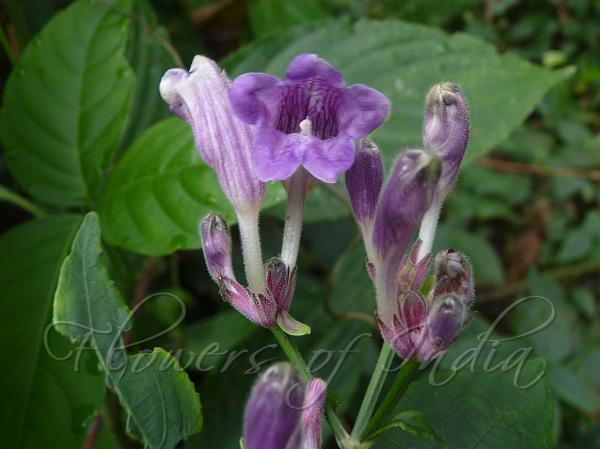|
| Rhombic-Leaf Coneflower |
|

|

| File size | 640403 |
| Original date | 12/31/22 10:12 PM |
| Resolution | 4000 x 3000 |
| Flash | Flash did not fire, auto |
| Focal length | 5.0mm |
| Exposure time | 1/40s |
| Aperture | 2.8 |
| Focus Distance | |
| Metering Mode | Multi-segment |
| Camera make | Panasonic |
| Camera model | DMC-FZ35 |
| Sensor type | OneChipColorArea |
|
|
|
|
Photo: |
Botanical name: Strobilanthes rhombifolia Family: Acanthaceae (Acanthus family)
Rhombic-Leaf Coneflower is a perennial herb or
subshrub, strongly anisophyllous. Flowers are blue, 4-4.5 cm, outside
sparsely gland-tipped hairy but becoming hairless; tube basally
cylindric and about 2 mm wide for about 1 cm then widened to 1.2-1.7 cm
at mouth; lobes nearly round, about 6 x 7 mm. Sepal-cup is nearly
equally 5-lobed to base; sepals linear-elliptic, 7-12 x about 1.2 mm,
velvet-hairy and with stalkless glands. Stamens are 4, not protruding,
style about 2.7 cm. Flowers are borne in leaf-axils, in flower-heads
borne on simple or 2-3-furcately branched flower-cluster-stalks, 2-10
cm. Flower-cluster-stalks are grooved, bifariously velvet-hairy with
trichomes in sulci; sterile bracts leaflike, ovate, about 0.5 x 0.5 mm,
relatively persistent. Floral bracts are obovate to oblong-obovate,
about 6 x 1.5 mm, soon scarious and falling off. Stems are 4-angled,
erect, hairless. Leaf-stalks are 0-1 cm but apical leaves stalkless;
leaf blade rhomboidal-elliptic, 2-15 x 1.5-10 cm, both surfaces green
and with abundant cystoliths, secondary veins about 6 on each side of
midvein, base wedge-shaped and shortly decurrent onto leaf-stalk,
margin sawtoothed, tip pointed. Rhombic-Leaf Coneflower is found in
Arunachal Pradesh, Assam, Nagaland, and Tibet. Flowering:
December-January.
| Identification credit: John Wood | Photographed in East Siang distt., Arunachal Pradesh. |
• Is this flower misidentified? If yes,